An efficient product roadmap is an integral part of any successful product.
Effective product managers lead their teams toward a vision of the future, and to do so they lean on product roadmaps.
The purpose of a product roadmap is to identify key steps to take and when to take them.
Crafting a product roadmap is no different from planning a road trip. Think about the last trip you planned. You likely first began by identifying key destinations, key dates, and a theme of what kinds of experiences you wanted to get from your road trip.
In all likelihood, then you dove into research to flesh out the details of each particular stop on the trip. Based on the details, you then had to work through trade-offs. In doing so, you added, removed, or changed the sequence of destinations based on the constraints that you faced at the time.
Product managers do this all the time for their product teams. They take on these road-mapping exercises to lead their teams on a journey toward the product vision of the company. If you’re interested in learning more via video, then watch below. Otherwise, skip ahead.
Let’s take a better look at the concept of a product roadmap:
What is a Product Roadmap?
A product roadmap is a guide that describes the steps you need to take to reach your product goals. It’s a plan of action that lines up a product’s short-term and long-term goals. It also outlines how you hope to achieve those product goals.
Product roadmaps can span a variety of timeframes. That’s because different companies and teams can have different timelines.
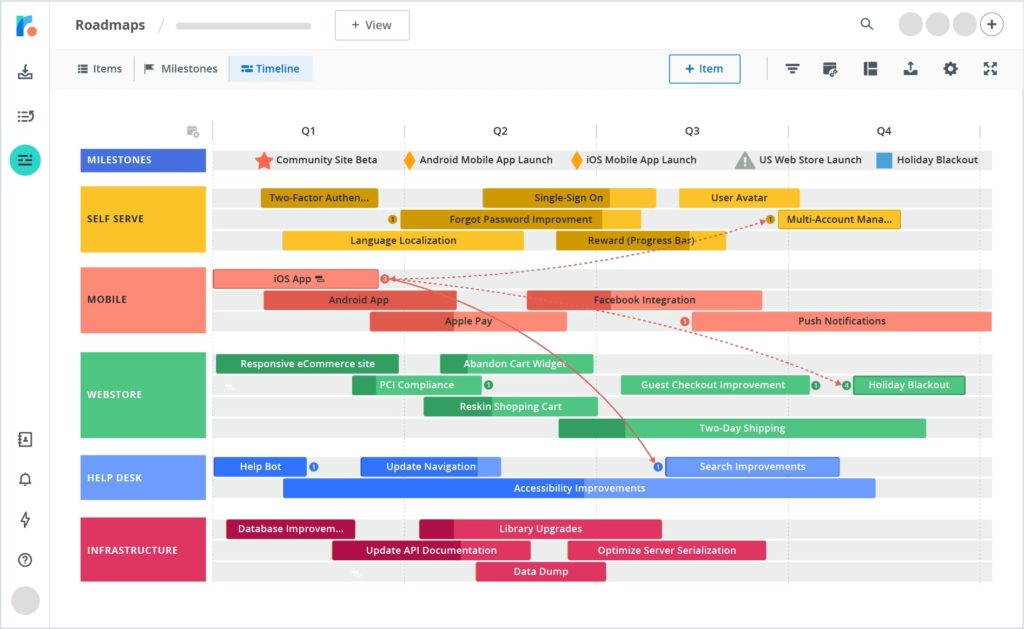
Credits: Roadmunk
For example, one way to pull together a product roadmap is to paint a forecast 12 months into the future. Some product managers find it easier to look at these twelve months as four quarters. The first quarter will be at 90% confidence, the second quarter at 70% confidence, the third quarter at 50% confidence, and the fourth quarter at 30% confidence.
Types of Product Roadmaps
There are several types of product roadmaps. Each one is more or less useful depending on different factors. Let’s take a look at some of the most common types of product roadmaps and how they will help you achieve your product goals.
1. The Evolutionary Roadmap
This roadmap is a great tool for keeping everyone in sync when there isn’t a lot of information about how the final product will look.
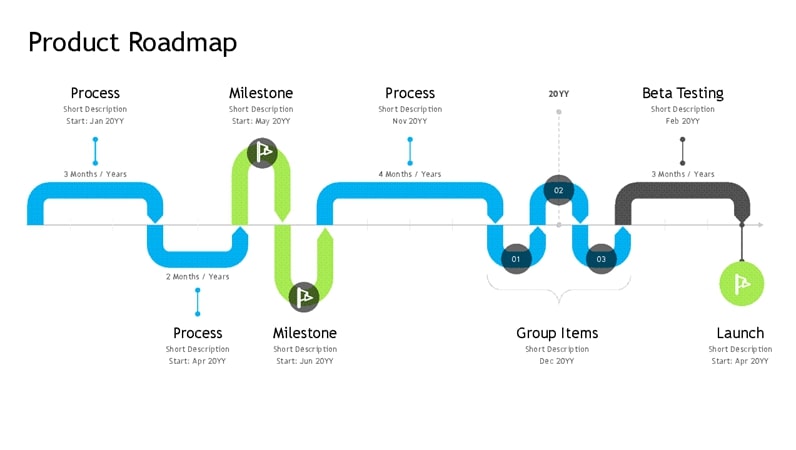
Credits: Medium
This type of roadmap is a solid choice to keep developers, designers, and project managers in sync.
2. The Release Roadmap
This is the product or marketing team’s most important tool to communicate with the customer community about what features are going to be released and when.
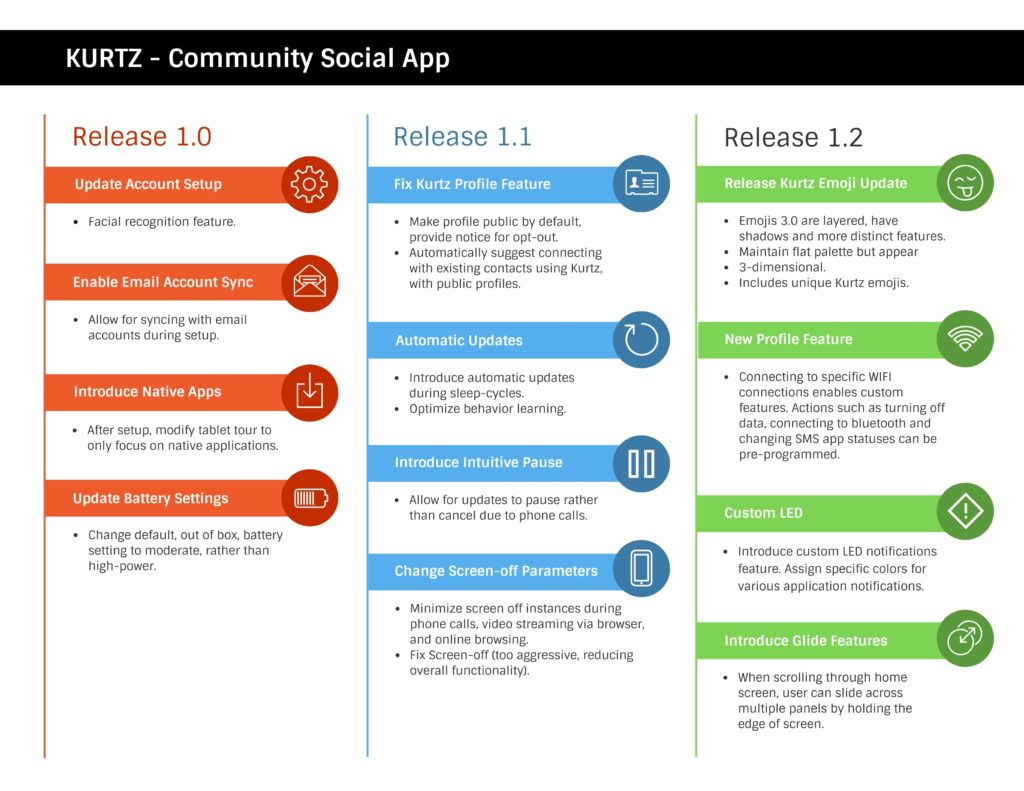
Credits: Venngage
Product managers create release roadmaps once the product team has accomplished significant work on all major features planned for the release.
3. The Theme Roadmap
This roadmap is a logical way to communicate the next features that will be implemented to meet company goals or customer needs.
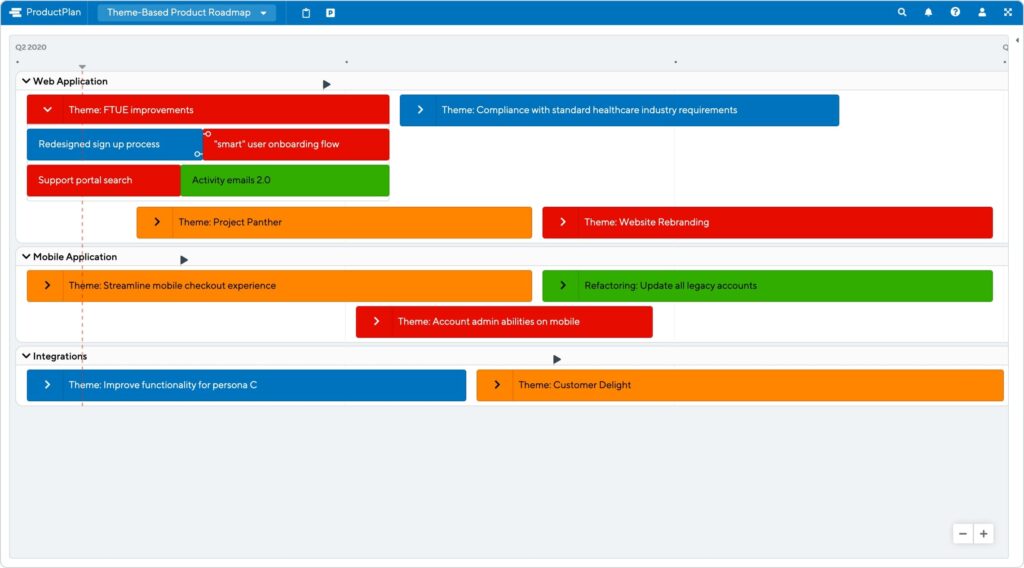
Credits: Product Plan
This map indicates where the product is going and how it plans to get there.
4. The Timeboxed Roadmap
This is similar to the release roadmap but has more specifics about certain features or types of releases. Similar to a release roadmap, this map is detailed. However, it does not include dates.

Credits: Asana
It serves as a reminder and communication for the team that work should be completed in time for a certain date.
5. The Capacity Roadmap
This one is similar to the release roadmap but without dates. Capacity roadmaps serve as communication tools among departments or functions and show the types of products that the team will create.
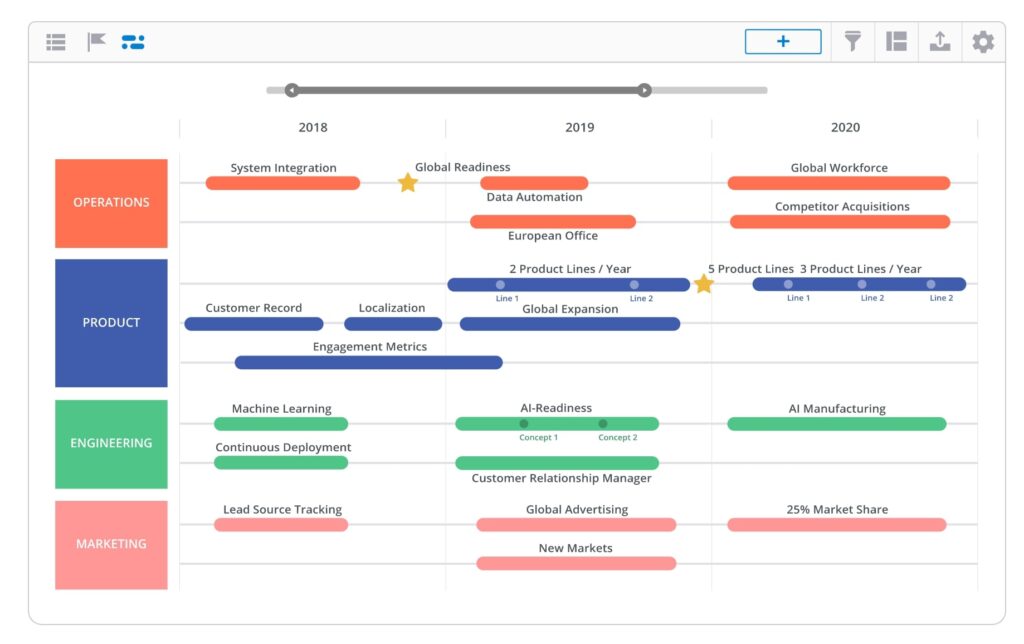
Credits: Roadmunk
Product managers tend to use this product roadmap to discuss resources needed as opposed to specific deliverables.
6. The Market Requirements Roadmap
This roadmap helps a company steer its product and market positioning.
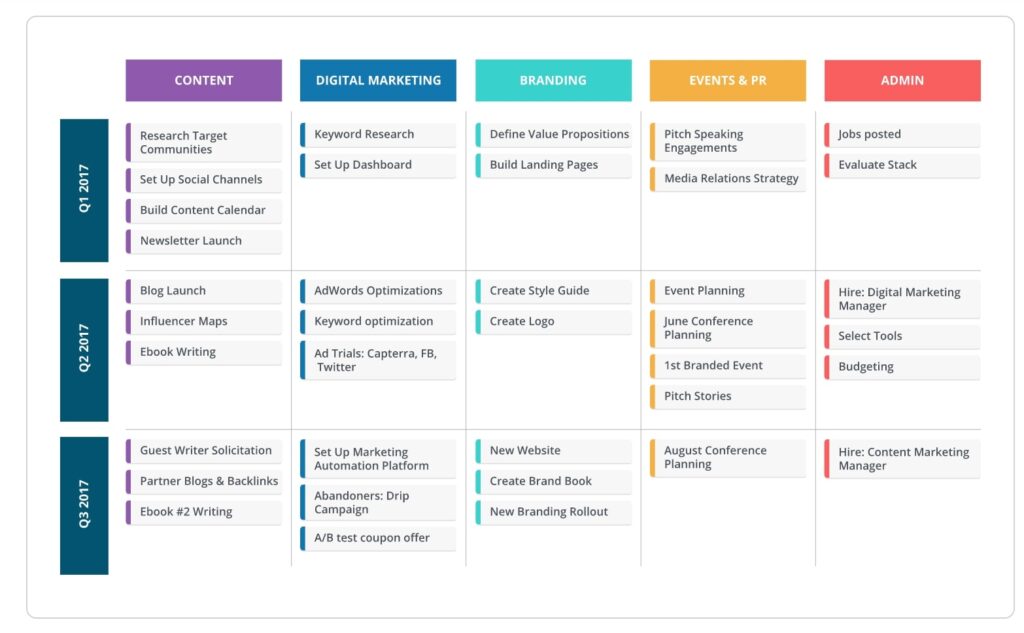
Credits: Road Munk
It also shows how the plan and types of products match the requirements of the customer or user base.
7. The Opportunity Roadmap
This one is used for companies that sell to businesses. It helps align business development efforts with strategic initiatives so that customers can be acquired in a coordinated way. For example, product managers create this type of roadmap once a significant amount of work has been completed on all major features planned for the release.
8. The Project Roadmap
Product leaders use this roadmap to align teams and individuals working on different products or projects with each other.
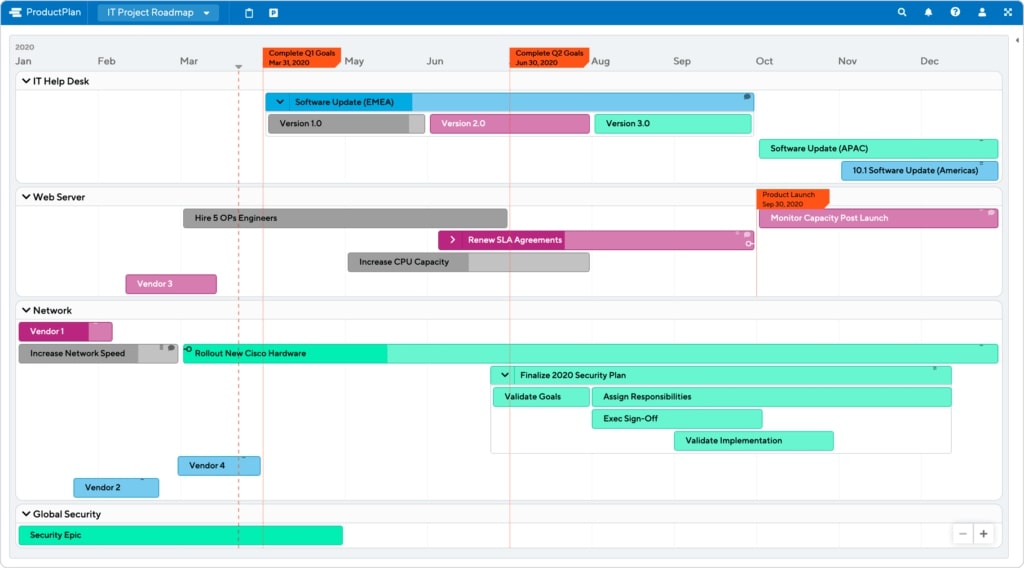
Credits: Product Plan
It lets people see how their work fits in with the rest of the company’s plans for that release.
How to Build a Product Roadmap
The first step in building a product roadmap is defining the product strategy. That comes from the vision you have for the product. Then, you and your team will need to gather information from two main sources. Those are your customer support or sales team and your product users.
This will give you a good base for assigning a timeframe to your initiatives.
Keep in mind that a product roadmap should be a strong foundation for all decisions, but it should be flexible. After all, the landscape might change and you might need to re-prioritize.
Hidden complexity, bugs, or delays could also shift your roadmap. So, it’s not possible to be 100% confident in any quarter, and it’s also hard to maintain the same level of confidence when projecting multiple quarters out because each future quarter contains additional uncertainty.
Of course, you should never build product roadmaps in a vacuum. Your roadmap should enable you to move product goals and business objectives forward. You should tie your roadmap to North Star metrics and counter metrics to keep your product goals moving forward.
You want to build towards the big picture. A good way to is by asking yourself how will your product yield value to your customers in a crowded competitive landscape.
Your product value will then take us to another point you will want to know before getting into the roadmapping process.
Why is a Product Roadmap Important?
A powerful product roadmap is built to serve a product strategy.
In product management, you’re faced with multiple viable alternatives all of the time. A product strategy mandates that you select one viable alternative out of many and that you say ‘no’ to many other alternatives.
Because a roadmap forces you to take your journey one step at a time, it means that you will take a specific step in a specific sequence. This helps the team to have a structured plan to follow.
Of course, product roadmaps are always subject to change. The power of being agile and flexible means that product managers are always re-evaluating their roadmaps based on new information, and they will reach into their product backlogs to identify whether there are better sequences of work to tackle. This will enable the business to reach targeted business goals.
As the team works through product development, you’ll gather new information that will validate or disprove your current hypotheses. From here, you and your product team will iterate through new versions of the product roadmap.
Product Roadmaps Serve a Larger Purpose
They’re also powerful tools for aligning internal stakeholders with the direction that your product is headed. As an example, providing sales teams with visibility on where your product is headed will enable them to sell more confidently in the field. Doing so allows you to secure the buy-in of executives from various internal departments.
You’ll also be able to provide clarity to external stakeholders such as customer executives and customer users. If you decide to publish your product roadmap, you can set expectations around which new features are in scope, which are out of scope, and when they can expect you to deliver those items.
Furthermore, by sharing with customers, you can gather feedback from customers on why certain items should be added or removed. Many times, roadmaps can even be used to sell or persuade customers to buy into the startup’s current offering so that they can be part of upcoming improvements or features down the line.
When done the right way, product roadmaps are powerful tools that enable product managers to drive impact and alignment across key stakeholders.
Almost all product professionals today use product roadmaps. Asking other product experts is a great way to see how they go around the concept.

Product Roadmap Template
Although each team may use different tools to maintain a product roadmap, even simple tools like a Google spreadsheet or a Microsoft Excel document can enable you to craft compelling roadmaps.
First, a product roadmap should be kept high-level and should not dive deep into any single identified feature.
One simple way to structure your product roadmap is to ensure that each row includes the following columns:
- New product feature idea
- User story and requirements
- Effort required
- You’ll have to work with your team to figure out the best way to define the effort required. This could be a time or $ cost
- Sequence
- Which items should be done first? Which items should be done later? Be sure to use prioritization to identify what will give you the strongest ROI, or return on investment.
- Estimated release date
- Remember to keep this high level and either come up with or work with your engineering manager to estimate the time required to complete the feature
Of course, a product roadmap means tackling multiple features within some sequence, so you’ll need to first start from a list of features before you have a roadmap.
Best Product Roadmap Tools
While product managers tend to be tool-agnostic, you can get ahead of the curve by familiarizing yourself with these popular roadmapping tools.
- ProdPad: This lets you capture ideas and feedback, create product specs, and build a product roadmap.
- ProductPlan: This lets you plan and communicate your product roadmap.
- ProductBoard: System of record for product management that helps teams make products people want.
- Aha!: Web-based product strategy and roadmapping software for agile product managers.
- Roadmunk: Visual roadmap software for product management.
- Jira: A flexible and scalable issue tracker for software teams.
- Excel: A straightforward way to put together your thoughts.
- Google Sheets: Easy for startups to use to quickly collaborate on feature ideas.
Start Delivering Great Products
Product managers are in charge of taking their products and their teams on a journey towards a brighter future. To do so, product managers create roadmaps that ladder up to the company’s vision. These roadmaps enable product managers to guide their teams, align internal stakeholders, generate excitement from current customers, and convert new prospects.
By understanding the possible steps you can take to get to your vision and sequencing them in a compelling way based on current constraints, you can deliver a successful product.
Interested in learning more about product roadmaps? You might want to check out our popular Product Manager Certification Course. You’ll learn the fundamentals of product management, how to launch your side project, and how to dominate product manager interviews.
